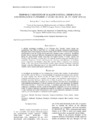Identificador persistente para citar o vincular este elemento:
https://accedacris.ulpgc.es/jspui/handle/10553/106501
| Campo DC | Valor | idioma |
|---|---|---|
| dc.contributor.author | Riera, Rodrigo | en_US |
| dc.contributor.author | Nunez, Jorge | en_US |
| dc.contributor.author | Brito, María del Carmen | en_US |
| dc.date.accessioned | 2021-04-06T10:54:33Z | - |
| dc.date.available | 2021-04-06T10:54:33Z | - |
| dc.date.issued | 2014 | en_US |
| dc.identifier.issn | 1679-8759 | en_US |
| dc.identifier.uri | https://accedacris.ulpgc.es/handle/10553/106501 | - |
| dc.description.abstract | A subtidal meiofaunal assemblage in Los Cristianos Bay, Tenerife, Canary Islands was sampled from May 2000 to April 2001, at 3 m depth. Nematodes dominated overwhelmingly during the study period, ranging from 84.52% in May 2000 to 95.93% in October 2000. Copepods and polychaetes were the second and the third most abundant groups, respectively. Meiofaunal densities showed significant differences throughout the study period, with minimum abundances during the spring-summer months (May-July) and highest densities in winter (January and February). This seasonality is mainly due to the temporal variations of the most abundant species (nematodes Daptonema hirsutum and Pomponema sedecima), with differences in meiofauna species composition and abundance during May and June 2000 as compared to the remaining months of the study period. Environmental variables partly explained meiofaunal community structure, being the sedimentary type of very fine sands the most important, jointly with other variables, such as nitrogen and organic matter content. | en_US |
| dc.language | eng | en_US |
| dc.relation.ispartof | Brazilian Journal of Oceanography | en_US |
| dc.source | Brazilian Journal of Oceanography [ISSN 1679-8759], v. 62, n. 3, p. 167-177 | en_US |
| dc.subject | 240119 Zoología marina | en_US |
| dc.subject.other | Subtidal | en_US |
| dc.subject.other | Meiofauna | en_US |
| dc.subject.other | Nematodes | en_US |
| dc.subject.other | Temporal distribution | en_US |
| dc.title | Temporal variations of shallow subtidal meiofauna in los cristianos bay (Tenerife, Canary Islands, Ne Atlantic Ocean) | en_US |
| dc.type | info:eu-repo/semantics/article | en_US |
| dc.type | Article | en_US |
| dc.identifier.doi | 10.1590/S1679-87592014027406203 | en_US |
| dc.identifier.scopus | 2-s2.0-84908085218 | - |
| dc.contributor.orcid | #NODATA# | - |
| dc.contributor.orcid | #NODATA# | - |
| dc.contributor.orcid | #NODATA# | - |
| dc.description.lastpage | 177 | en_US |
| dc.identifier.issue | 3 | - |
| dc.description.firstpage | 167 | en_US |
| dc.relation.volume | 62 | en_US |
| dc.investigacion | Ciencias | en_US |
| dc.type2 | Artículo | en_US |
| dc.identifier.external | 47301287 | - |
| dc.description.numberofpages | 11 | en_US |
| dc.utils.revision | Sí | en_US |
| dc.identifier.ulpgc | No | en_US |
| dc.contributor.buulpgc | BU-BAS | en_US |
| dc.description.sjr | 0,362 | |
| dc.description.jcr | 0,662 | |
| dc.description.sjrq | Q3 | |
| dc.description.jcrq | Q4 | |
| dc.description.scie | SCIE | |
| item.grantfulltext | open | - |
| item.fulltext | Con texto completo | - |
| crisitem.author.dept | GIR ECOAQUA: Biodiversidad y Conservación | - |
| crisitem.author.dept | IU de Investigación en Acuicultura Sostenible y Ec | - |
| crisitem.author.dept | Departamento de Biología | - |
| crisitem.author.orcid | 0000-0003-1264-1625 | - |
| crisitem.author.parentorg | IU de Investigación en Acuicultura Sostenible y Ec | - |
| crisitem.author.fullName | Riera Elena, Rodrigo | - |
| Colección: | Artículos | |
Citas SCOPUSTM
2
actualizado el 08-jun-2025
Citas de WEB OF SCIENCETM
Citations
3
actualizado el 08-jun-2025
Visitas
94
actualizado el 27-jul-2024
Google ScholarTM
Verifica
Altmetric
Comparte
Exporta metadatos
Los elementos en ULPGC accedaCRIS están protegidos por derechos de autor con todos los derechos reservados, a menos que se indique lo contrario.
